Block 32 of the Block a Week CAL (hosted by Kimberly Slifer) is Joyce D Lewis’ Crocodile Flower Square. I love how the crocodile stitch looks, but have never been a fan of the work involved in making it. That being said, I absolutely love this square and there was a strange, meditative rhythm to making the crocodile stitch petals.
UPDATE 2015: This square is no longer free. You can buy it HERE on Ravelry. Joyce is happy for me to keep this partial photo tutorial on my website, but you WILL need to get the pattern in order to complete the square as this tutorial is only a helpful guide, not the complete pattern.

Crocodile Flower Crochet Square
{Pattern © 2014 Joyce Lewis. Photo tutorial done with kind permission}
Pattern
Available to buy on Ravelry.
You can also join Joyce on Dunnica Lane (her Ravelry Group), where there is a discussion specifically aimed at The Crocodile Flower.
Suggested Materials
- 4 mm Clover Amour Crochet Hook (US G/6 UK 8)
- Worsted weight yarn
Size
- Using the hook and yarn specified, your square should be a nice even 12″ when you are done. Joyce does say that she is a very tight crocheter, so your square might come out bigger!
- Using a 4 mm crochet hook (US G/6 UK 8) and double knit yarn, as I have done, your finished square will be 8.5″ big IF you stop at Round 13 and leave out Rounds 14-17. Please note that you will still need to make Rounds 18-20, which form the crocodile stitch petals.
My Yarn and Colour Choices
I am using Stylecraft Special DK.
- Saffron (Rounds 1-4)
- Fondant (Rounds 5 and 20)
- Pomegranate (Rounds 6 and 19)
- Lipstick (Rounds 7, 8, and 18)
- Sherbet (Rounds 9 – 13)
- Meadow (Optional Round 14)
Please Note that I changed the Optional Round to Sherbet in my final afghan.
Notes
- Joyce uses chain stitches to start her rounds, which is not unusual in and of itself, but they way she uses them is different than what you might be used to. In Round 5, for example, the initial ch-2 counts as a chain stitch and a sc.
- US Crochet Terminology used. (See this comparative chart if you need help transcribing from US to UK)
- If you feel like practising the invisible join, feel free to use it whenever you change colours.
- Please Note: The yarn used for the photo tutorial below is DROPS Paris Cotton.
Special Stitches
- Crocodile stitch – this stitch has a slightly different configuration in each of the 3 rounds it is used in. It is explained in each of those rounds.
- Bubble stitch – the bubble stitch is made slightly differently in each of Rounds 2 – 4, but consists either of a (sc, tr) or a (sc, tr, sc).
- Long double crochet
Crocodile Flower Square Photo Tutorial
This photo-walkthrough is NOT the actual pattern and should not be used instead of the pattern, but rather in conjunction with it.
Thank you very much to Joyce Lewis for giving us permission to do this photo-tutorial for her Crocodile Flower Square. And a special thank you to Kimberly Slifer for letting me do these tutorials and for obtaining the necessary permission.
Round 1
As written.
If you are not familiar with working into a magic ring, this video tutorial from Moogly is clear and easy to follow.
Please remember, when working into a magic ring you HAVE to work away your initial tail very well. If you just cut it, your whole square might unravel!
Stitch count: 12 dc’s – including initial ch-3
Round 2
Ch 1 and TURN so that the back of Round 1 is facing you. This round (and the next 2) will be worked with the wrong side of the work facing you.
It is important to note that the back end of the slip stitch join looks like a stitch, although it isn’t and should not be worked into. Whatever you decide to do, make sure that you only have 12 bubble stitches at the end of this round, not 13!
Place a piece of scrap yarn over your work before making the first st of this round (Photo 1). Make a tr in the same st as the sl st join. You will find this stitch to the right of the stitch marker (left if you are left-handed). See Photo 2. Skip the back end of the sl st join (indicated with an arrow in Photo 3) and (sc, tr) in the next st (Photo 4). When making the bubble stitches, make sure that the treble pops out away from you.
Repeat around as instructed in the pattern. Join to the first ch with a sl st (indicated with an arrow in Photo 5 and illustrated in Photo 6).
Count your bubbles!
Stitch count: 12 bubbles {24 st’s}
Round 3
In this round you will be working only into the sc’s, not the tr’s! In Photo 4 below I have marked the tr’s with outlined arrows, and the sc’s with solid arrows. Notice that the tops of the trebles appear bigger than the tops of the sc’s.
Remember that the wrong side of the work should still be facing you and the bubbles should be facing away from you!
I forgot to remove the stitch marker from Round 2 before taking the first 3 photos, sorry :)
Ch 1. Place a piece of scrap yarn over your work. (Tr, sc) in the same st as the sl st join (Photos 2 and 3). *Skip the next tr (topmost right arrow in Photo 4). (Sc, tr, sc) in the next sc (indicated with the bottom right arrow in Photo 4 and illustrated in Photos 5 and 6)* 11 times.
Join to the initial ch st with a sl st. Photo 8 shows you what the flower center should look like on the right side at this point.
Stitch count: 12 bubbles {36 st’s}
Round 4
In this round you will again be working only into the sc’s, not the tr’s. To help you identify the trebles, it is useful to know that their top loops will appear slightly larger than the tops of the sc’s. They will also fall directly in front of a bubble stitch.
Below you will find a view of the stitches from the back, which should be facing you (left), as well as a view of the stitches slightly from the top, showing the bubbles(right).
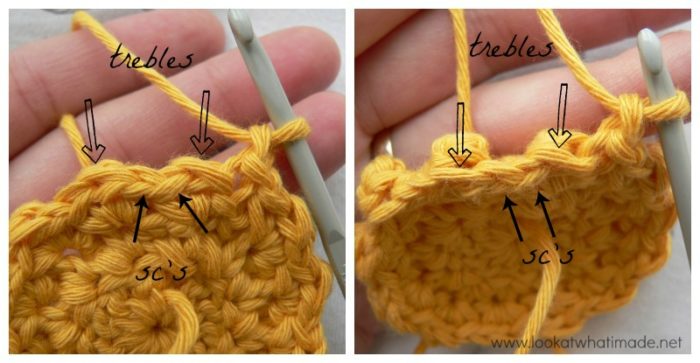
Ch 1. Place a piece of scrap yarn over your work. *Skip the next tr. (Sc, tr) in the next sc (Photos 1 and 2), sc in the next sc (Photo 3)* 11 times. Join to the initial ch st with a sl st (indicated with an arrow in Photo 5). Fasten off and work away your tails of yarn.
Photos 4 and 5 show the last bubble stitch of the round being made.
Stitch count: 12 bubbles {36 st’s}
This is what your flower center should look like from the right side. Notice that the bubbles in each round fall between the bubbles of the previous round.
Round 5
From this point onwards, you will work with the right side facing you. So turn your center so that the bubbles are all smiling at you, not at your lap.
A last reminder of how to identify the trebles. They should be directly behind each bubble stitch and their top loops will also be slightly larger than those of the sc’s.
Joyce instructs you to join your yarn by making a sl st, followed by a ch-2. I prefer starting with a standing single crochet instead, but it is totally up to you!
Join your yarn by making a standing single crochet in the first sc after any tr around (Photo 1). Sc in the same st. Make 2 sc’s in the next st (Photo 2).
*Ch 5 (Photo 3) and sl st into the sc at the base of the ch-5, creating a ch-5 loop (indicated with an arrow in Photo 3 and illustrated in Photo 4). Skip the next tr (Photo 5) and make 2 sc’s in each of the next 2 sc’s*.
Repeat as instructed in the pattern and join to the first sc with a sl st. Fasten off and work away your tails of yarn.
Stitch count: 48 sc’s and 12 ch-5 loops
Round 6
Join your yarn by making a sl st in the first sc after any ch-5 loop. Ch 4 (counts as first tr) – see Photo 1.
As written.
When making the sl st into the side of the treble, insert your hook under the top 2 loops of the tr, but from the side. I don’t really know how to explain this bit, hehe, and got all the way to Round 20 before I realized exactly where to make the sl st.
If you have difficulty making this sl st, insert your hook between the posts, or “legs” of the 2 tr’s and make a sl st around the post of the last tr instead, as I did before I realized how to do it properly (Photos 4 and 5). In this round (and the next), it doesn’t matter which way you do it. It will only matter when you get to the surface crochet bit in Round 18.
Fasten off at the end of this round and work away your tails of yarn.
Stitch count: 36 tr’s, 12 ch-3 spaces, and 12 ch-6 loops
My husband planted some flowers this week, so I figured I’d take a picture of my crocodile flower visiting the flowers.
Round 7
As written.
The initial ch-8 counts as a (tr, ch-4). When joining, remember to join to the fourth ch of the beginning ch-8.
Stitch count: 36 tr’s, 12 ch-4 spaces, and 12 ch-6 loops
This is what you should end up with.
Round 8
This round should preferably be done in the same colour as the previous round, as it will be visible later when adding the crocodile stitches, but I have used a new colour to better illustrate where the stitches go.
- If you are using the same colour, sl st into the next ch-4 space. Ch 1 and make 4 sc’s in the same ch-4 space.
- If you are using a new colour, join your yarn by making a standing single crochet in any ch-4 space around. Make 3 more sc’s into the same ch-4 space.
Sc in the next tr (Photo 1). Ch 2 and hdc in the tr after the ch-6 loop (indicated with an arrow in Photo 2). (2 hdc, 2 dc) in the next ch-4 space (Photo 3). Make 3 tr’s in the next tr. Ch 3 and make 3 tr’s in the tr after the ch-6 loop (Photo 4). (2 dc, 2 hdc) in the next ch-4 space. Hdc in the next tr (Photo 5). Ch 2 and sc in the tr after the ch-6 loop (Photo 6).
Repeat as instructed in the pattern and join to the first sc with a sl st.
Stitch count: 96 st’s, 8 ch-2 spaces, and 4 ch-3 corner spaces {24 st’s and 2 ch-2 spaces per side}
Pop the ch-6 loops to the front of your work.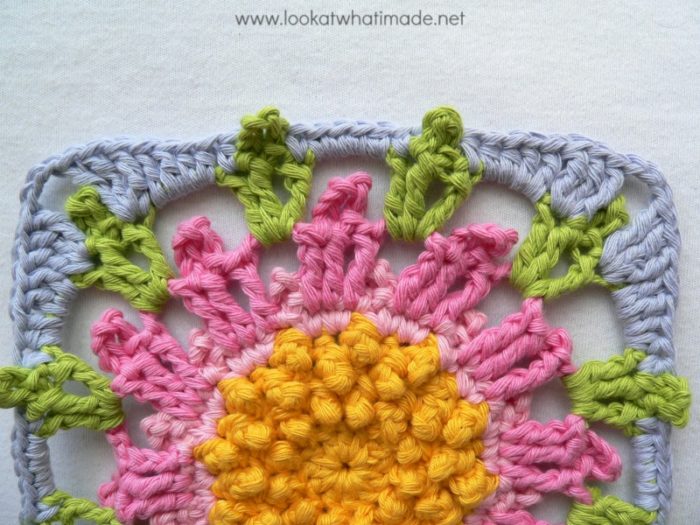
Rounds 9 – 13
As written, my beauties. These rounds are simple sc and dc rounds.
Round 18
Now we will start adding the petals. Brace yourself! You will be starting with the outer round of petals, so use the same colour as you used for Round 7.
In this round you will need to work into the ch-4 spaces from Round 7. Each of these ch-4 spaces already have 4 stitches worked into them from Round 8. You will need to insert your hook between the central 2 stitches and around the ch-4 (see Photo 1).
With a slip knot already on your hook, and starting between the central 2 sc’s of Round 8 on any side, insert your hook around the ch-4 from Round 7 (Photo 1). Make 6 tr’s into the next ch-6 loop and then ch 1. Flatten the petal and locate the stitch in Round 12 or 13 that lies behind the petal (Photo 2). Insert your hook around the post of that stitch (Photo 3) and make a sl st. Ch 1 and make a sc into the side of the last of the 6 tr’s you made into the ch-6 loop. Photo 4 illustrates the hole you should make your sc into. Photo 5 shows the sc made. If you cannot locate this hole, which is below the top 2 loops of the tr, you can insert your hook around the post of the tr instead, but it won’t be quite as neat (Photo 6).
Now make 6 more tr’s into the same ch-6 loop (Photo 7). Finish the petal by making a sc around the next ch-4 space from Round 7, again inserting your hook between the 2 central stitches (from Round 8) made into the ch-4 space (Photos 8 and 9).
Repeat around and join as instructed in the pattern.
When you “tack” down the corner petals, I suggest inserting your hook around the ch-3 space from Round 10, between the 2 corner sc’s from Round 11 (Photos 10 and 11).
Stitch count: 12 Petals (each containing 12 tr’s) and 12 sc’s between petals
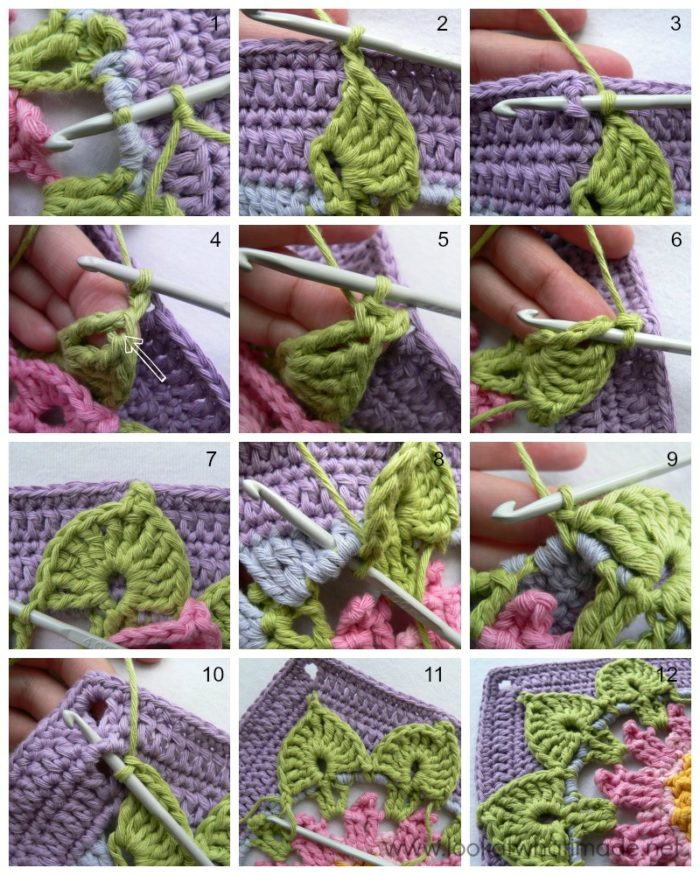
Round 19
Use the same yarn as you used for Round 6.
Join your yarn by making a sl st around any ch-3 space from Round 6, remembering to insert your hook between 2 of the tr’s from Round 7 (that you made into the ch-3 space) – see Photo 1. Make 6 dc’s in the next ch-6 loop from Round 6. Ch 1 (Photo 2). “Tack the petal down by making a sl st in the sc between petals from Round 18 (indicated with an arrow in Photo 3). Ch 1 and sc into the side (top) of the last of the 6 dc’s you made into the loop (Photo 4). Make 6 more dc’s into the same ch-6 loop (Photo 5). Complete the petal by making a sc around the ch-4 from Round 6, between any 2 tr’s from Round 7 (Photo 6).
Repeat around and join as instructed.
Stitch count: 12 Petals (each containing 12 dc’s) and 12 sc’s between petals
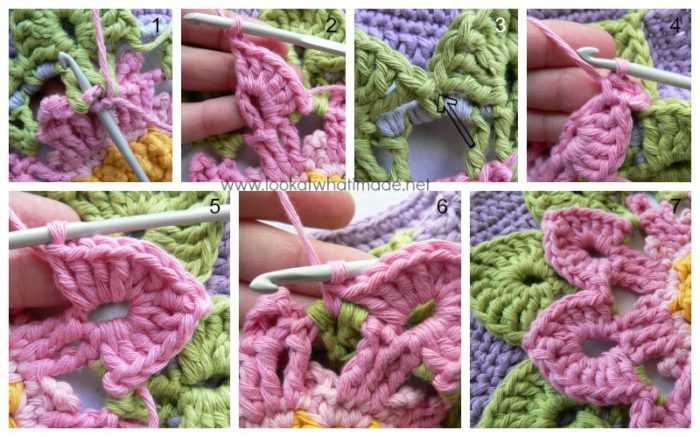
Round 20
By this time you should be churning out crocodile stitches like a machine!
Do this round as written.
I found it hard going getting into the front vertical loops of the sc’s from Round 5, so I inserted my hook around the post of one of the sc’s instead.
I have included photos, should you need some visual clues, but this round is very much like the previous 2.
Stitch count: 12 Petals (each containing 10 hdc’s) and 12 sc’s between petals
To get my square to the same stitch count as the previous squares, I have added an optional Round 14. I really wish this square was slightly smaller, because I love the look of the saw-tooth outer rounds on the original and would have loved to add them!
Remember to subscribe to my Weekly Newsletter if you would like to be kept in the loop. You can also like my Facebook page or follow me on Bloglovin, Google+, Pinterest, Twitter, or Instagram.
Happy Hooking!


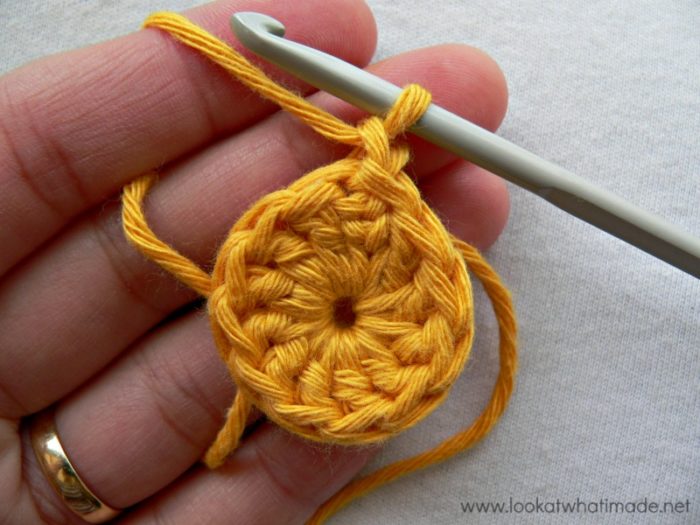

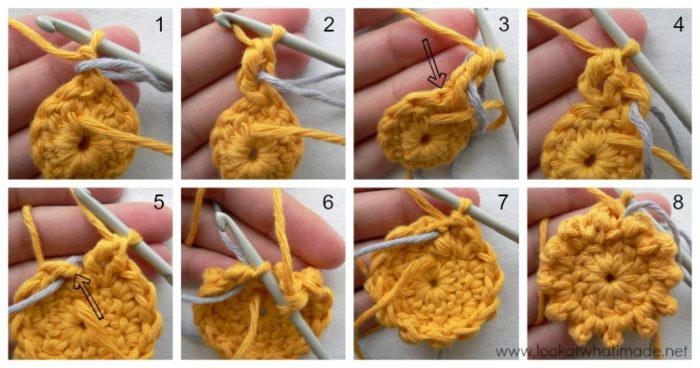
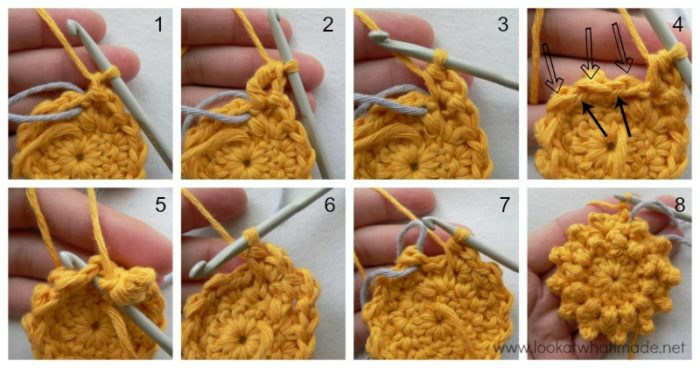
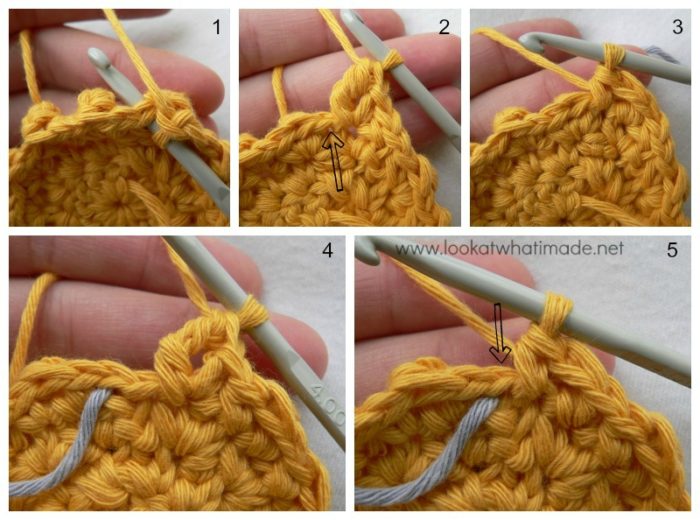
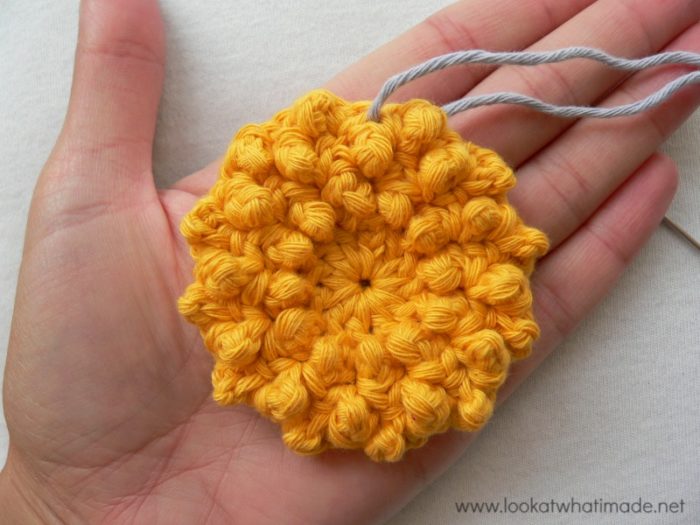
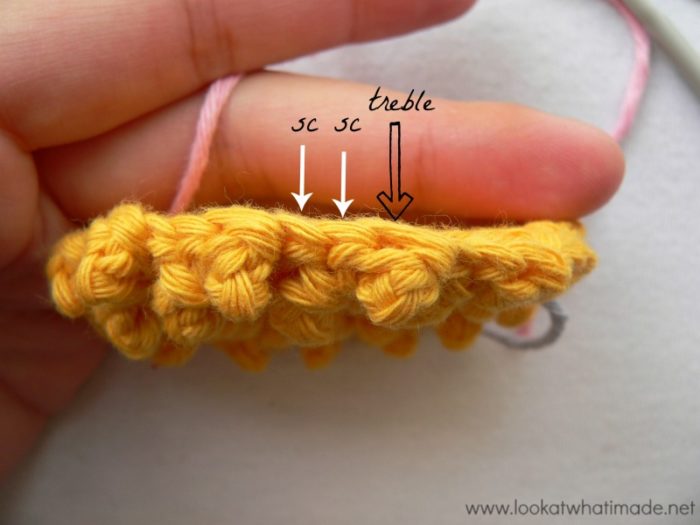
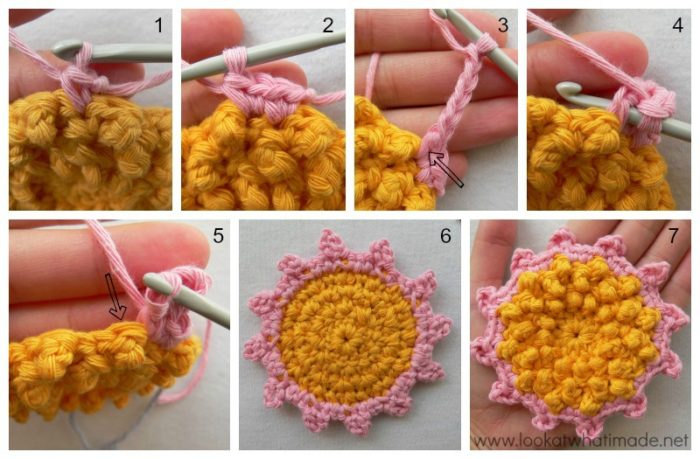
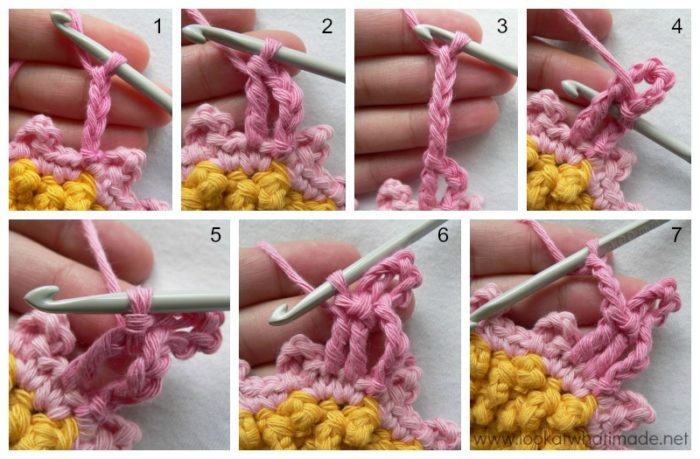
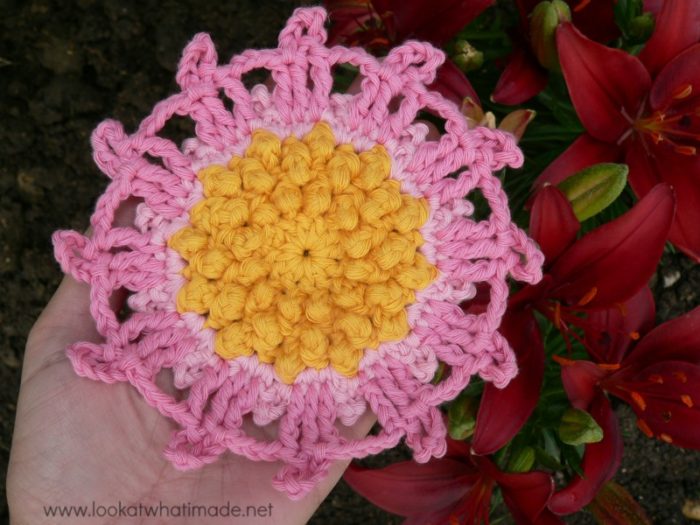
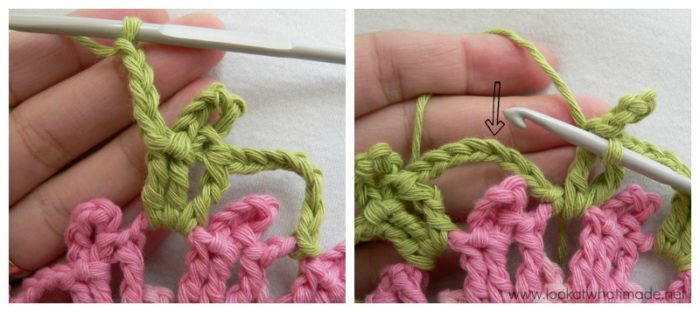

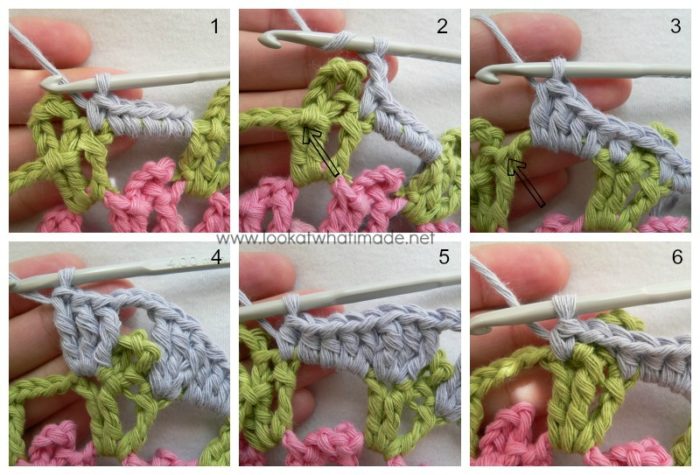
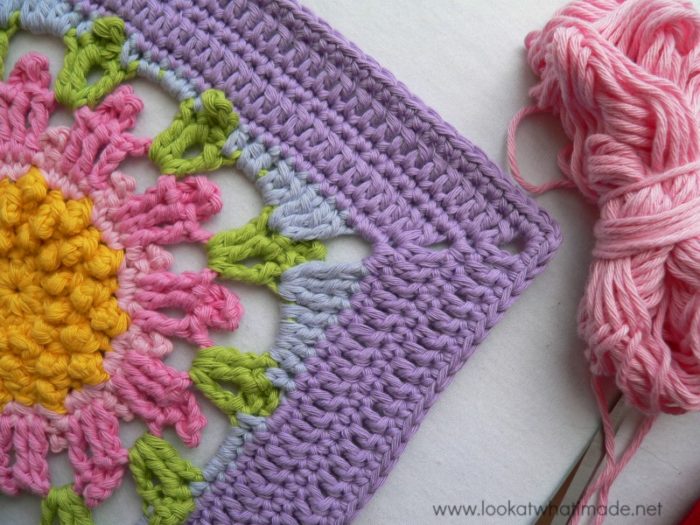
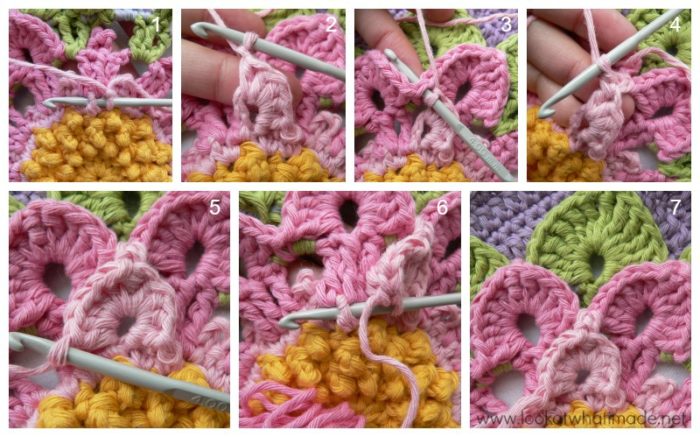
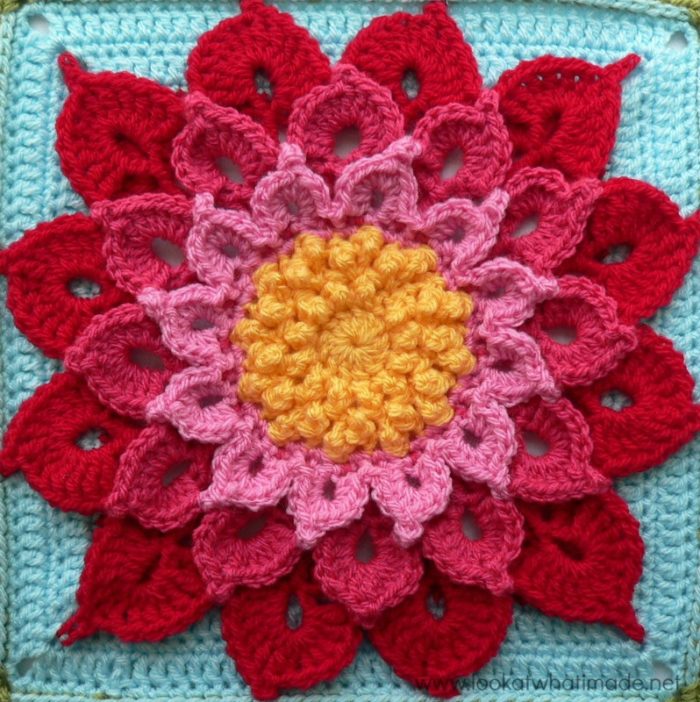




Alexandra Nielsen says
Thank you soooooooo much for this tutorial! I’m not great at following patterns anyway, but with your instructions I had success! Turning mine into a cushion cover.
nejla dolapci says
hı Dedri ! very beautiful hand made ,it’s color ‘s perfect l applied ıt was very nice Thank you very much
Dedri Uys says
You’re welcome, Nejla :)
Charlene says
I just discovered your site and I have to tell you I love it. I can’t wait to start exploring. Thank you!
Dedri Uys says
Hi Charlene. Welcome to Look At What I Made :)
vidu says
can you please show the tutorial of Crocodile Stitch Afghan Block – Dahlia?
i am not able to do after round 3
thank you
Dedri Uys says
Hi Vidu. I have not got permission to do the whole square as a photo tutorial. I have, however, covered the first 5 rounds in detail. What are you struggling with on Round 4?
Lynette Kingipoitiki says
Hi I am from new Zealand, Love this pattern, but am having trouble with Round 6. Not sure what im actually supposed to do. help please.
Dedri Uys says
Hi Lynette, have you bought the pattern or are you just following the photo tutorial? Which part of Round 6 are you struggling with?
Pallie says
I am not sure if it will help anyone out there, but Joyce does have a smaller version of this block still available for free on Ravelry. It may seem like a waste to many people, but taking scrap yarn and working with a larger hook to make the stitching easier to work, can get you adjusted to doing stitches the way they are done in this block.
Tulu says
Thanks a lot im writing from Turkey and look for this crochet model .im so happy now thanks again
Cheryl says
Thank you so much for the wonderful tutorials! I have used them for so many squares. I do have one problem with this square. The first time I made it the background was quite wavy. It seemed as if there were too many stitches.
Any ideas what I can be doing wrong?
Dedri Uys says
Hi Cheryl. That’s a very broad question. Was it wavy before or after blocking (or both)? Did your stitch counts tally or did you have too many stitches? Have you got a photo of your square?
Dedri
Lily Rae says
Okay, I give up XD First, thank you for ALL the photo tutorials available on your site, it’s honestly a pleasure to browse everything :D
So I was trying this pattern without the original at first, for the challenge, but the 18th round had me stumped. It was fair enough, so I went to buy the pattern, but… No help at all T__T I can’t figure how to make the first treble starting from the slip stitch, my yarn is everywhere and it’s all very awkward to reach for the ch6 loop :/ Any advice? ♥
Dedri Uys says
Hi Lily Rae. If you use the contact me option at the top of this page to contact me, I will respond and you can then send me a photo so that I can help you. Alternatively you can visit Joyce’s group on Ravelry and ask her for assistance.
Dedri
A. says
Hello! The pattern isn’t available for free anymore. I don’t know when it became paid, but it must have been sometime after November, as that’s when I went through each square and saved it to my ravelry library in case it became paid before I could make it (very glad I did that!). You may want to update the tutorial, as with other blocks that became paid that’s what you did. Thanks for all the tutorials, and have a nice day!
Dedri Uys says
Thank you for that. I hadn’t realized. I will update the post.
Dedri
Ray says
Thank you for the tutorial. Much appreciated as its easier to follow than the original pattern. Saying that I do need help with Round Six please. I can’t quit now :/
Muchos gracias
Jenny says
What’s your problem with round 6, Ray? I am sure we can help :)
vanessa says
This is the most magnificant piece of work I have ever seen. Your demonstrations and tuturials are the best. I can not compliment you enough… i will be trying to make this. I have to look what a half double crochet is. This is the only part I need to look at. Thank you so much….Vanna
Jenny says
Hi Vanna! We are so pleased you like Sophie! HDC is like DC but you pull through all three loops at once instead of pull through two, YO and pull through two as you do for DC.
Good luck on your voyage with your Sophie :)
Hulya Yuvali says
Hi,
What an incredible job and great effort to share this tutorial with us, the addicted crocheters !! Just started and it goes on very well indeed..
Love from Dushle
Jenny says
We hope you enjoy your journey Dushle :)
Michelle says
These are the best directions I have every used! So easy to follow. I really appreciate the effort you put into it. Thank you thank you!!!
Dedri Uys says
You are most welcome!
Karen Howard says
Oh- these are Both so Gorgeous! I love the Colors & Patterns. I wish I could crochet these myself-but I’m not very good at regular stiches -so this would really be a challenge for me. I might be able to get my Mom to make them for me though -If I print the patterns & buy the E. Floss. She makes doilies- not like these, but still very pretty.
Carmen says
Me encanta, es inmensamente precioso. Me gustaría hacerlo, ¿sería posible verlo en vídeo?. Gracias por tanta belleza.
Un saludo,
Carmen
briana says
In your pictures are you using cotton? The link you posted at the beginning of the post went to Amazon and it was acrylic yarn but the yarn you use in your pictures looks so much like cotton. Truly beautiful! thank you so much for your wonderful blog.
Dedri Uys says
The final block is made with Stylecraft Special DK acrylic. The photo tutorial is done using DROPS Paris Cotton.
Veronika says
Just after making it in greys and pinks for my to be coming baby girl’s baby blanket centre square and I love the look of the edge in original pattern. She doesn’t have instructions there. How do you make it . Could you help p
Dedri Uys says
Hi Veronika. The instructions are in the written pattern. You want Rounds 14 onwards, where it says sawtooth.
lillian says
I love the crocodile flower sq. But your direction s are hard to follow. You talk about how to slip st in ring but don’t say what to do then give what u end up with same rnd 7..so I just stopped writing the pattern:(
Dedri Uys says
Hi, this is not the pattern for the Crocodile Flower, only a photo tutorial to help you with the Crocodile Flower. You can find the full pattern here: http://www.ravelry.com/patterns/library/the-crocodile-flower
Rhondda says
Another fantastic tutorial Dedri!!
This is one of my favourite blocks so far I think!!
Rhondda
Dedri Uys says
Thank you, Rhondda. I’m just amazed at how Joyce came up with the design. It must have taken her ages and ages!